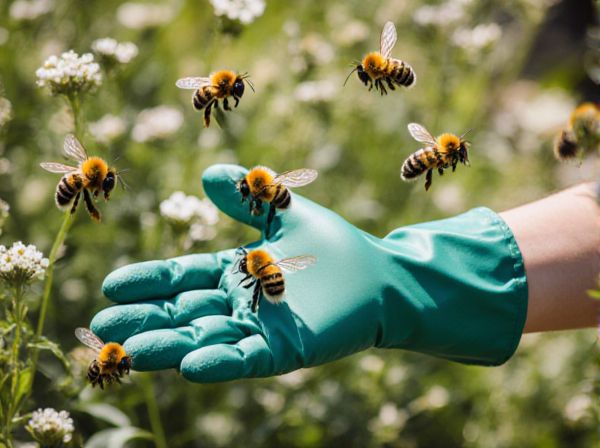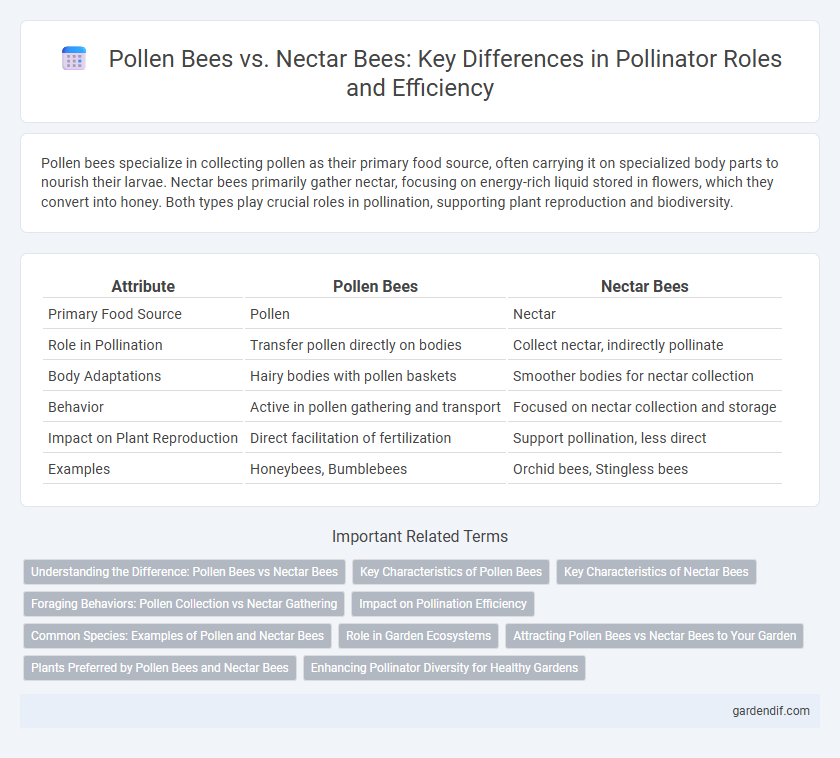
Pollen Bees vs Nectar Bees Illustration
Pollen bees specialize in collecting pollen as their primary food source, often carrying it on specialized body parts to nourish their larvae. Nectar bees primarily gather nectar, focusing on energy-rich liquid stored in flowers, which they convert into honey. Both types play crucial roles in pollination, supporting plant reproduction and biodiversity.
Table of Comparison
| Attribute | Pollen Bees | Nectar Bees |
|---|---|---|
| Primary Food Source | Pollen | Nectar |
| Role in Pollination | Transfer pollen directly on bodies | Collect nectar, indirectly pollinate |
| Body Adaptations | Hairy bodies with pollen baskets | Smoother bodies for nectar collection |
| Behavior | Active in pollen gathering and transport | Focused on nectar collection and storage |
| Impact on Plant Reproduction | Direct facilitation of fertilization | Support pollination, less direct |
| Examples | Honeybees, Bumblebees | Orchid bees, Stingless bees |
Understanding the Difference: Pollen Bees vs Nectar Bees
Pollen bees primarily collect pollen, serving as vital pollinators by transporting pollen grains between flowers to facilitate fertilization and plant reproduction. Nectar bees focus on gathering nectar, which they convert into honey, but they also inadvertently transfer pollen, contributing to pollination. Understanding these distinct roles clarifies their unique contributions to ecosystem health and agricultural productivity.
Key Characteristics of Pollen Bees
Pollen bees are specifically adapted to collect and transport pollen, featuring branched hairs called scopal hairs on their legs or abdomen that trap pollen grains efficiently. Unlike nectar bees, which primarily gather nectar for energy, pollen bees play a critical role in pollination by ensuring pollen transfer between flowers. Their robust body structure and specialized pollen-carrying adaptations make them indispensable for the fertilization of many plant species.
Key Characteristics of Nectar Bees
Nectar bees primarily collect nectar from flowers, which they convert into honey and use as their main energy source, distinguishing them from pollen bees that focus on pollen collection for protein. These bees typically have longer proboscises, enabling them to access nectar from deep floral structures efficiently. Their behavior and anatomy optimize the pollination process by facilitating nectar foraging while inadvertently transferring pollen between flowers.
Foraging Behaviors: Pollen Collection vs Nectar Gathering
Pollen bees specialize in collecting pollen, which they use as a protein source to feed their larvae, exhibiting behaviors such as pollen packing on their hind legs. Nectar bees primarily gather nectar, focusing on carbohydrate-rich liquid to sustain the adult colony and produce honey, often visiting a wide range of flowering plants. These distinct foraging behaviors influence their roles as pollinators, with pollen bees contributing more directly to pollination through pollen transfer.
Impact on Pollination Efficiency
Pollen bees carry dense loads of pollen on their hind legs, directly transferring large quantities to flowers, which significantly boosts pollination efficiency by ensuring higher fertilization rates. Nectar bees primarily gather nectar and incidentally collect pollen on their bodies, resulting in less targeted pollen transfer but contributing to broader flower visitation and genetic diversity. The specialized foraging behavior of pollen bees makes them more effective pollinators for crops dependent on pollen deposition, whereas nectar bees enhance ecosystem pollination through increased floral interactions.
Common Species: Examples of Pollen and Nectar Bees
Pollen bees, such as sweat bees (family Halictidae) and mining bees (Andrena spp.), are specialized in collecting pollen to provision their nests. Nectar bees include species like honeybees (Apis mellifera) and bumblebees (Bombus spp.), which primarily forage for nectar as an energy source. Both groups play crucial roles in pollination but differ in their foraging behaviors and resource preferences.
Role in Garden Ecosystems
Pollen bees play a crucial role in garden ecosystems by actively collecting and transferring pollen, which directly facilitates plant reproduction and increases fruit and seed production. Nectar bees primarily gather nectar for energy and contribute to pollination more indirectly, often visiting flowers less frequently or less systematically than pollen foragers. The combined activities of pollen and nectar bees enhance biodiversity, improve crop yields, and sustain the health of flowering plants within gardens.
Attracting Pollen Bees vs Nectar Bees to Your Garden
Pollen bees are primarily attracted to flowers rich in pollen, such as goldenrod and dandelion, while nectar bees prefer flowers with abundant nectar like lavender and bee balm. To attract pollen bees, plant a diverse array of pollen-heavy blooms that provide a continuous supply throughout the growing season. For nectar bees, incorporate nectar-rich plants with vibrant colors and strong floral scents to maximize foraging activity in your garden.
Plants Preferred by Pollen Bees and Nectar Bees
Pollen bees predominantly prefer plants with abundant, easily accessible anthers such as sunflowers, dandelions, and clover, where pollen is plentiful for collection and feeding their larvae. Nectar bees, on the other hand, favor nectar-rich flowers like lavender, eucalyptus, and foxglove, which produce high volumes of nectar optimal for honey production and energy. Differentiating plant preferences between pollen and nectar bees supports targeted planting strategies to enhance pollination efficiency and biodiversity.
Enhancing Pollinator Diversity for Healthy Gardens
Pollen bees actively collect and transport pollen, making them essential for effective pollination and plant reproduction, while nectar bees primarily gather nectar for energy. Enhancing pollinator diversity by supporting both pollen and nectar bees promotes robust garden ecosystems by ensuring a wide range of plants receive adequate pollination. Providing varied floral resources and nesting habitats attracts diverse pollinator species, boosting garden health and productivity.
Pollen Bees vs Nectar Bees Infographic

 gardendif.com
gardendif.com